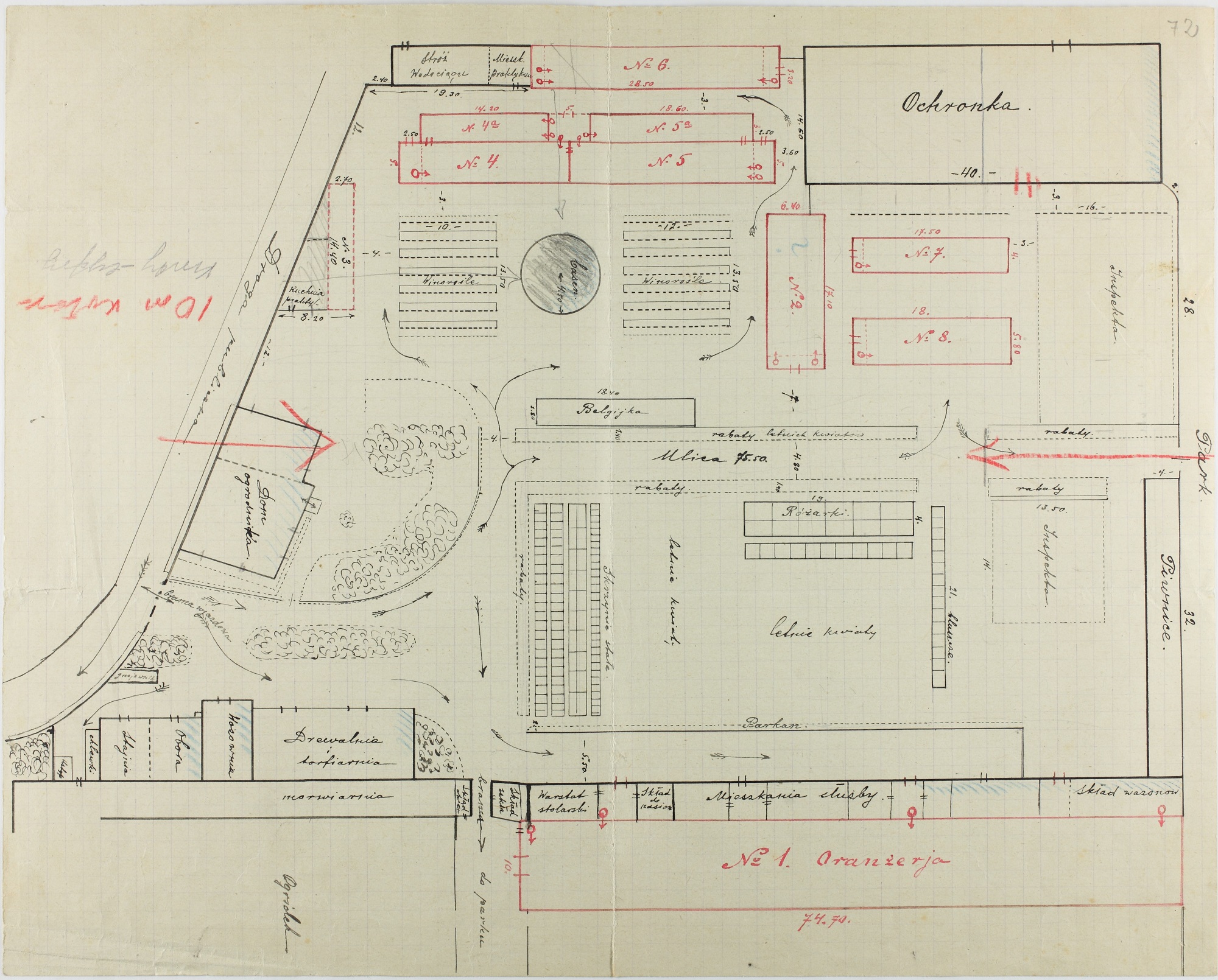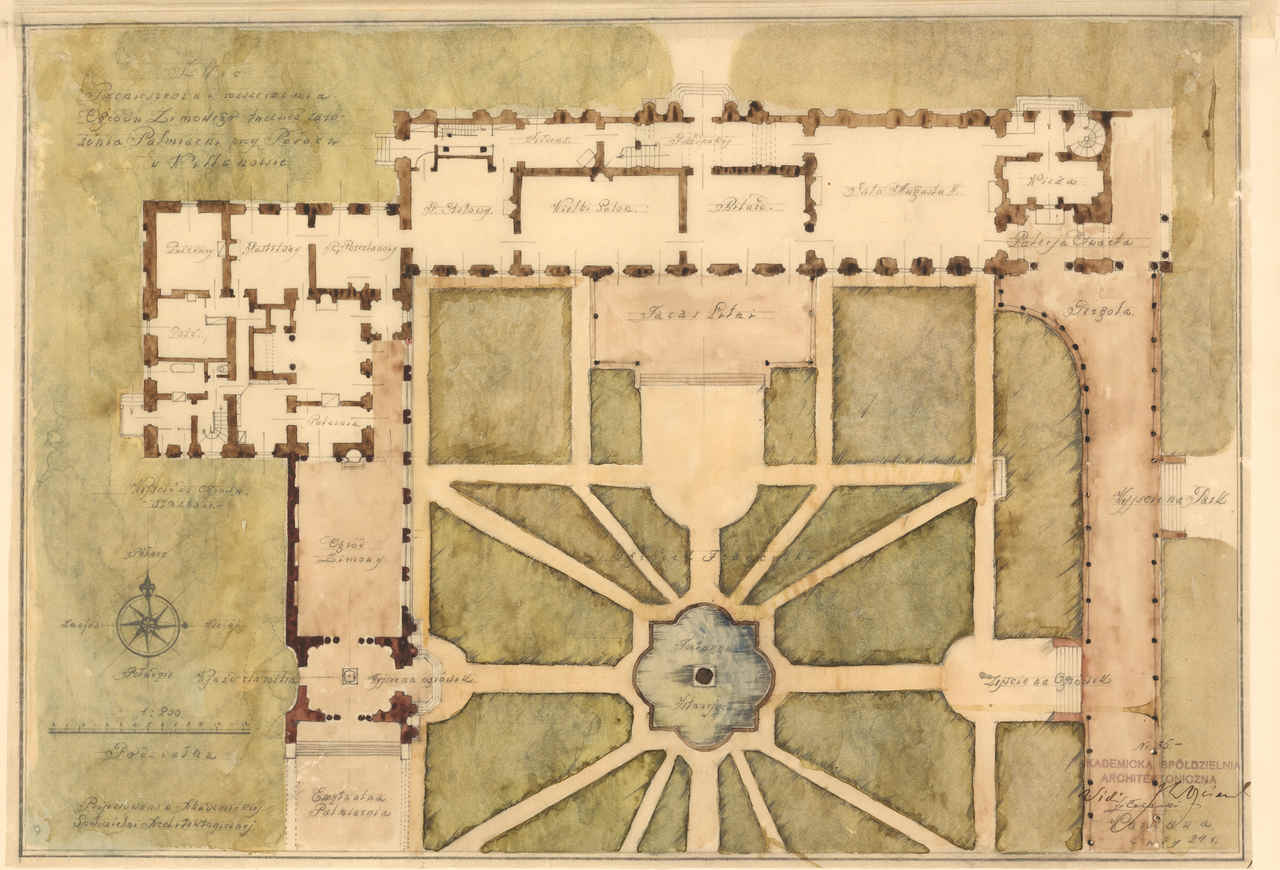From the end of the nineteenth century up to the 1940s, a series of dramatic events continued to take its toll on Wilanów and was far from sparing the exotic plant collections. Many of the Wilanów specimens perished in the war. Economic crises necessitated the transformation of orangeries and greenhouses into production facilities, and so their botanical resources ceased to form a collection. Usually centuries-old trees and edible fruit-bearing plants or plants with decorative flowers were earmarked for sale. Among them were the particularly valued citruses. At the time, many species popular earlier were still being cultivated: citrons (Citrus medica), common lemons (Citrus limon), limettas (Citrus limetta) also known as sweet limes, bergamot oranges(Citrus bergamia), bitter (Citrus × aurantium) and sweet oranges (Citrus sinensis), myrtle-leaved oranges (Citrus myrtifolia), and clementines (Citrus nobilis). New species appeared, such as a mandarin hybrid (Citrus × deliciosa) and kumquats (Citrus japonica), at the time called dwarf oranges. Orangeries and greenhouses also evolved; they were modernized and equipped with modern heating systems. In 1937, Jan Łebkowski published his “Greenhouses: Orangeries and Other Glass Buildings. Construction and Use” (“Cieplarnie: oranżerie i inne budynki oszklone - ich budowa i użytkowanie”), the first synthetic and professional technical description of all aspects of greenhouse facilities. It included detailed information about greenhouse types and the process of their construction, necessary materials, heating, airing and shading, waterworks, sewage and drainage, equipment, and main cultivation practices, watering, and rules of grouping plants depending on their needs concerning light, humidity, and temperature. Łebkowski identified a number of buildings which lent themselves well to exotic plant cultivation: cold frames (single-slope) and Belgian frames (double-slope), glass halls, cold greenhouses (min. 5°C in winter), warm greenhouses (min. 10°C in winter), hot and dry greenhouses (8–14°C in winter, 28–35°C in summer), hot and humid greenhouses (min. 10°C in winter, max. 30°C in summer), propagators, orangeries for evergreen plants (5–8°C in winter), orangeries with glass roofs called conservatories, cold winter gardens (min. 4°C in winter), temperate (min. 8°C in winter), and warm (min. 12°C in winter), aquariums for water plants and collection greenhouses for specific plants: palmhouses, orchidhouses, fernhouses, and cactihouses.
Ksawery Branicki, Wilanów owner since 1892, continued growing exotic plants with the traditional methods developed by the Potocki family. Orangery trees in wooden pots bound in forged iron hoops accentuated the entrance to the Palace, the central fountain on the Upper Terrace, and the garden balustrade, they decorated the Palace façade overlooking the garden, and the Flower Garden (now Rose Garden). Plants grown in Wilanów greenhouses were formed into elegant flowerbeds and arabesques on the Upper Terrace. The gardens, supervised at the time by Stanisław Górski, delighted with their richness and diversity. Architect Kazimierz Kleczkowski, author of an exceptional essay on the beauty of Wilanów gardens and Palace, described their unique atmosphere with undisguised delectation: [...] Among various local and exotic plants, natural and artfully bound vegetation, architectural works, sculpture and paintings, placed in Wilanów grounds, there is a certain general harmony and unity, just like between various figures of a painting [...]. Orangery and greenhouse plants were one of the main decorative features of the Palace gardens. In 1895, gardener Hipolit Błażewicz wrote: [...] Wilanów, as a magnate residence, is probably unmatched in our country, both in terms of area, excellent location, surroundings, as well as gathered wealth of plants [...] In what now is the Northern Garden there were flowerbeds of canna lilies (Canna ‘Madame Crozy’ and Canna Warscewiczii), caladiums (Caladium sp.), alternanthera (Alternanthera sp.), and ever-blooming begonias (Begonia semperflorens 'Vernon'). Orangery plants were also placed along the Palace, with house pines (Araucaria excelsa) and old pomegranates (Punica granatum) attracting the most attention. On the Upper Terrace, in front of the garden-facing Palace façade, there were artful flowerbeds of boxwood and flowers. One of them was made of European fan palm encircled by coleuses, begonias, iresine, alternanthera, and echeverias. On the sides of the garden stood large Abyssinian banana trees (Ensete ventricosum). Wilanów gardens comprised a whole complex of utilitarian gardens and twelve warm and cold greenhouses and propagators with around 500 windows. There were also buildings intended for cultivating specific plants, like a peachhouse, or a vinehouse. The largest and oldest plants attracted the most attention, they were almost legendary. A 1909 article published in “Kurier Warszawski” stated that there were three very old black mulberries (Morus nigra) in the Wilanów fighouse, supposedly planted by King Jan III himself. The orangery was to house 200 orange tree specimens, including 20 brought in the times of the King Jan III, and eight pomegranates estimated to be 800-1,000 years old (sic!).

Wilanów gardening practices and plant collection were constantly changing. According to 1919–1920 inventories, the collection comprised 16,000 plants kept in the orangery, six hothouses (including a cameliahouse and pineapplehouse with a propagator), and in a Palace hothouse called “little orangery”. There were 62 bitter oranges (Citrus × aurantium) and six citrons (Citrus medica) there. However, the most precious were the six orchid species (Stanhopea tigrina, Stanhopea oculata, Vanda tricolor, Cymbidium lowianum, Paphiopedilum insigne, Coelogyne cristata), 180 specimens in total. All gardening was done by the chief gardener, eight apprentice gardeners, and seven assistants. The golden age of the Wilanów collection of exotic plants came to an end in the 1920s, when Ksawery Branicki lost his Ukrainian estates to the Bolshevik Revolution and income from Roś estates (now in Belarus territory) destroyed during the Polish-Bolshevik war, and was forced to restrict his expenses. A specially appointed committee of experts declared that the greenhouses in Wilanów were outdated and ruined. The collection was botanical, not utilitarian, and so it required a lot of work and money. It was recommended that the gardens be converted to a facility producing decorative flowerbed and cut plants, while sparing some parts, like the orangery collection and figs and mulberries, as a “memorial curiosity”.
June 1921 saw the reorganisation of Wilanów greenhouse plant production. The unprofitable pineapplehouse was shut down and transformed into a primrose (Primula obconica), cineraria (Cineraria), and cyclamen (Cyclamen) greenhouse. The afore-mentioned orchid collection was reduced to 30 specimens. Of the orangery collection, only plants considered useful for decorating the Palace and its surroundings survived. Gardening at Wilanów focused on producing plants for sale: fruit (pineapples, apricots, pears, plums, greengages, grapes), potted plants (chrysanthemums, primroses, cyclamens, cinerarias, hydrangeas, stocks, wallflowers ), flowerbed plants (pansies, forget-me-nots, begonias, geraniums, carnations), and cut flowers (stocks, asters, carnations, roses, lilacs). Grown plants were also planted in Wilanów garden flowerbeds and used to decorate Palace interiors. To celebrate the visit of the Romanian royal couple to Wilanów on 25 June 1923, Wilanów gardens provided 1,350 cut flowers, 80 potted flowers, 810 flowerbed plants, and 504 orangery and greenhouse plants, including among others Kentia palms, laurels, rhododendrons, azaleas, euonymus, and rubber plants. Apart from the renovation of the hothouse, the orangery on the southern side of the Palace was designated for demolishing. A new winter garden and a palmhouse were to be built in its place, as a side wing of the current ‘Markoniówka’. The building, which never came into existence, was to be 32 metres long and seven metres wide, and was designed by Warsaw architects Jarosław Wojciechowski and Zdzisław Celarski. Despite some efforts at modernizing the greenhouse, Wilanów Palace, Park and Orchard Keeper Jakub Uściechowski alerted his supervisors about its poor condition and the necessity of installing a central heating system. Large orangery plants also required rejuvenation and some corrective pruning to their crowns.

However, the indispensable renovation and modernization work did not take place until Wilanów became the property of its next owner, Adam Branicki, who acquired Wilanów with his wife Beata after his father’s death in 1926. Over the next three years, he had central water heating with a boiler, heaters, and a network of iron pipes installed. This enabled maintaining orangery temperatures as high as 14°C in wintertime, and 10°C in other hothouses. Additionally, the heating pipes were repaired, glazings and window frames were replaced, small metalworking repairs were performed, and the fireplaces and chimneys were rebricked. The orangery walls were newly plastered on the inside, and the shingle roof was renovated. At the time, the Wilanów orangery collection included 1,256 specimens and was under care of Tadeusz Gogolewski, the garden inspector, and Leonard Płócienniczak, the manager of the greenhouses. The collection was constantly modified. Adam Branicki was interested in expanding his collection by adding new plants. For instance, in November 1929 he exchanged correspondence with the Gottlieb Hentschel’s Toruń-based horticultural farm about the purchase of Kentia palms (Howea forsteriana), Canary Island date palms (Phoenix canariensis), red latans (Latania lontaroides), coconut palms (Cocos weddeliana), dracaenas (Dracaena indivisa), cast-iron plants (Aspidistra elatior), rubber plants (Ficus elastica), and araucarias (Araucaria excelsa).
Selling cut and potted flowers and decorative plants from Wilanów greenhouses brought significant income to the residence. This, however, was not enough. As the Branicki family found itself in financial straits, they were forced to limit their gardening expenditures, which had a negative impact on the condition of Wilanów gardens. World War II dealt the final blow. In September 1939, the German aerial bombardment of Warsaw set fire to the Wilanów orangery and fighouse. Both burned down, together with all plants kept inside. The orangery building was almost completely destroyed: the Korynthian portico and almost half of the walls collapsed. The remnants of the exotic plant collection still standing in greenhouses soon withered away, as new German governance failed to ensure they were cared for properly. Despite that, gardening at Wilanów carried on, and vegetables, cut flowers, and potted plants were grown in greenhouses and cold frames. Beata Branicka applied in vain to German authorities for reclaiming the seized horticultural holding. In 1941, the authorities of the Warsaw District, an administrative unit of the General Government, proposed to rebuild the destroyed orangery and establish a coffee house or restaurant there, but this plan was never fulfilled.
In 1942 Adam and Beata Branicki hired historic garden conservator Gerard Ciołek to prepare preliminary studies and a restoration plan for the Wilanów Palace garden and the parks in Natolin and Morysin. They were supposed to be a continuation of the conservatory work initiated by Stanisław Lorentz, director of the National Museum in Warsaw. Ciołek performed detailed measurements of the garden and its surroundings and conducted historical research, which included an analysis of archival materials. Gerard Ciołek presented the outcomes in Wilanów on 14 May 1943 at a conservational conference attended by Beata and Adam Branicki and esteemed representatives of the scientific world, i.a. Prof. Stanisław Lorentz, Prof. Tadeusz Tołwiński, Prof. Jan Zachwatowicz of the Warsaw University of Technology, and Dr Adam Stebelski–director of the Central Archives of Historical Records in Warsaw. Still, the restoration project was not executed before the end of the war. In August 1944, during the Warsaw Uprising, all documents prepared by Gerard Ciołek burned down in the Krasiński Library (now the National Library of Poland in Warsaw). One month later, Nazi forces drove Wilanów residents out of the district, and the Branickis were evacuated to Nieborów. The abandoned Palace park and gardens were devastated, which was the final blow to the Wilanów plant collection.
Translated by Katarzyna Bartkowiak
This article has been written as part of the “Citri et Aurea” project carried out in cooperation with the Uffizi Gallery – the Boboli Gardens in Florence, under the patronage of the European Route of Historic Gardens.

We would like to inform that for the purpose of optimisation of content available on our website and its customisation according to your needs, we use information stored by means of cookies on the Users' end devices. You can control cookies by means of your Internet browser settings. Further use of our website without change of the browser settings means that you accept the use of cookies. For more information on cookies used by us and to feel comfortable about this subject, please familiarise yourselves with our Privacy Policy.
✓ I understand